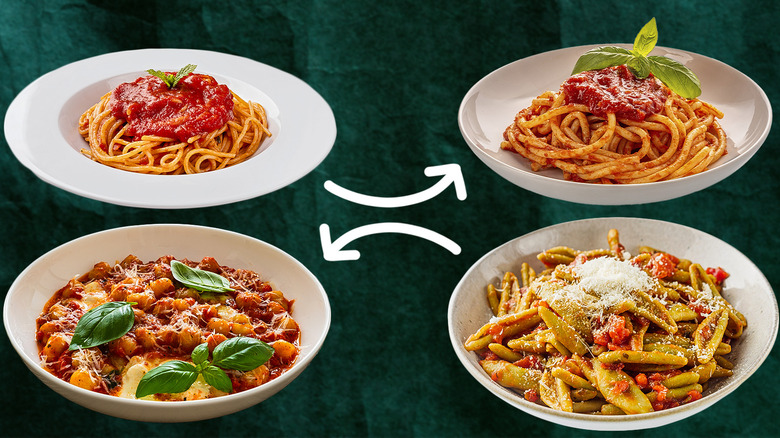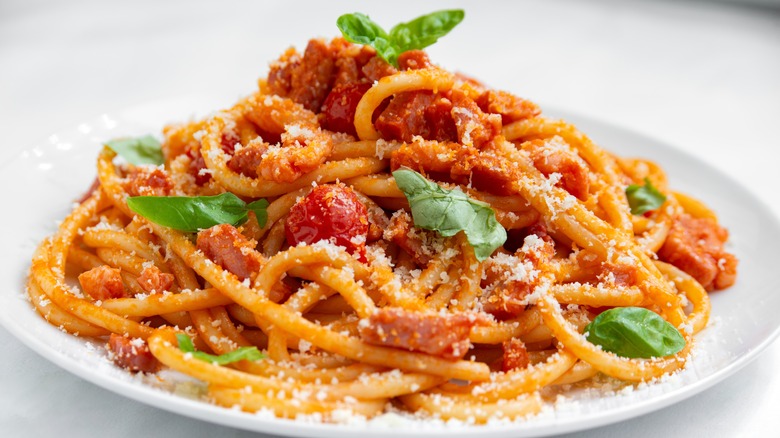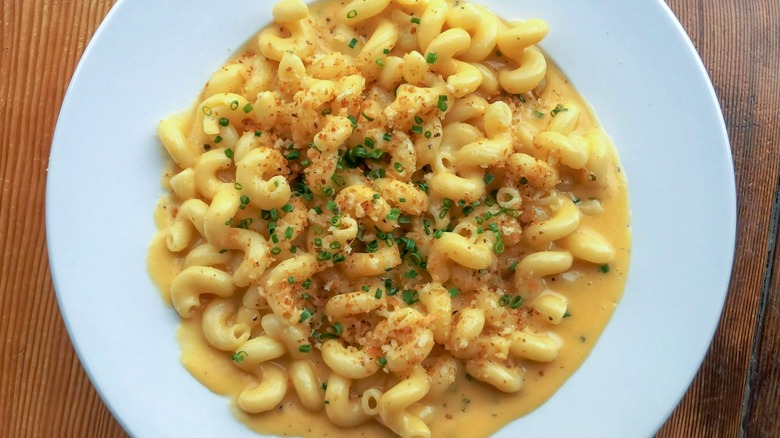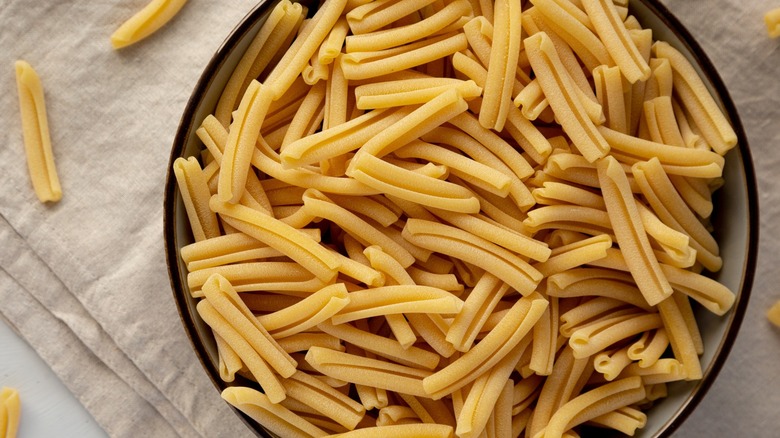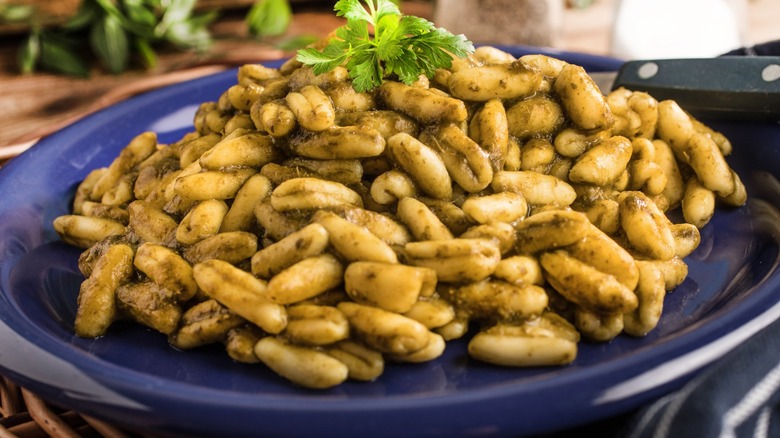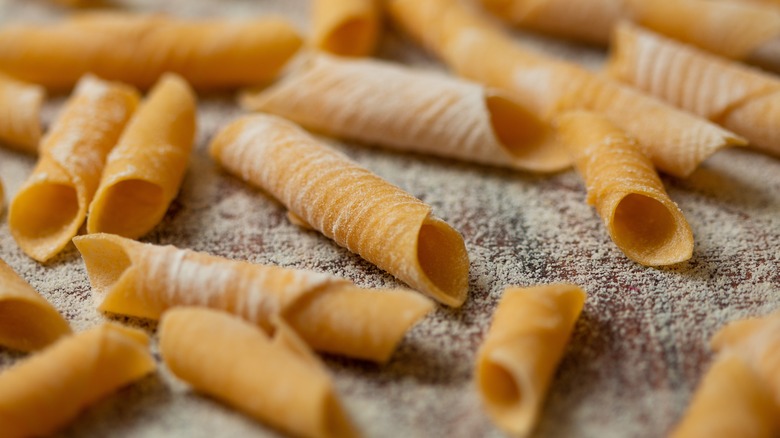5 Basic Pasta Shapes And The Unique Swaps You Should Use Instead
We may receive a commission on purchases made from links.
You may be hesitant about making a swap in your most beloved pasta recipes. Pasta does carry a lot of tradition, after all — but the wide world of pasta shapes is far too diverse to not explore. Most Americans are familiar with a decent range of pasta, penne, linguine, lasagna, and other supermarket staples, yet that only scratches the surface of what's available to you. By most counts, there are at least 350 different types of pasta out there, many of which are regional Italian designs made for specific dishes or sauces. And it's that kind of variety that makes exploring different pasta shapes so rewarding.
The shapes aren't just for fun, and even more well-known pasta usually have very specific reasons why they are shaped the way they are. So, here is the challenge to break out of your normal pasta habits and try something new. Nobody will be complaining when you serve your classic ragu alla Bolognese sauce with linguine or penne, but until you try it with some ribbony tagliatelle, you don't know what you are missing. These unique pasta swaps are not saying your classic shapes aren't doing a good job, just that for some dishes there are specialized players more directly suited for the task. And while the pasta shapes we recommend are less common than the basic ones you should swap them for, most of them are still relatively easy to find, either in grocery stores, specialty stores, or online.
For easy, classic sauces, swap out spaghetti for thicker bucatini
Spaghetti is the classic pasta shape in the U.S., so much so that it almost stands in as a term for pasta itself. However, its wide-ranging appeal causes it to suffer from a "jack of all trades, master of none" problem. Usually paired with classic tomato sauces and creamy favorites like carbonara, it gets the job done, but it can sometimes be too limp to hold up to heavier dishes. Enter bucatini. On the surface, it looks mostly like thicker spaghetti, and that's half the point, as it's sturdier construction gets less soggy in hearty sauces. But that's only part of it. The big upside it has over spaghetti is in the name, "buco," which means "hole" in Italian.
Bucatini's long tubes are hollow, with a small hole running through the center, which is perfect for catching more sauce in your pasta. Basically any dish spaghetti is used in will be improved by bucatini, but it really shines in simpler saucy dishes where you want as much surface area as possible on your pasta. The four classic Roman pastas, cacio e pepe, gricia, carbonara, and Amatriciana, are all wonderful with bucatini. The thicker strands will grip and absorb the rich sauces and still stand up to their flavor, while also being robust enough to really make a meal of the few ingredients each sauce uses. But don't sleep on a straightforward combo of bucatini and simple marinara sauce, either.
Macaroni salads and mac and cheese are better with cavatappi
Macaroni is one of the more interesting of the basic pasta shapes because it mostly gets used in soups, salads, and casseroles, not classic pasta dishes. It is usually there to fill out and hold together a jumble of ingredients, or simply to carry as much cheese as possible to your mouth. With that in mind, a better version of macaroni would just be a bigger version of it, and that's essentially what cavatappi is. Extending macaroni's famous elbow shape into a longer corkscrew means there is a stronger structure and more nooks for holding onto chunky ingredients and sauces, concentrating the flavor of baked pastas and other hearty dishes into one unified bite.
It's tough to say this to old macaroni, but mac and cheese recipes with cavatappi (cava and cheese?) is the superior form of the comfort food. The more hefty shape brings a better balance to stretchy, creamy melted cheese, which clings to the spiral perfectly instead of overwhelming it. The same goes for other macaroni favorites like chili mac, which will get picked up by the longer spirals for more tasty bites. Cavatappi also transforms creamy pasta salads. Instead of being overly heavy mayo fests, those recipes have a lighter touch on taste buds when spread out over the larger area of cavatappi. And unlike macaroni, cavatappi is also big enough to work in classic tomato and meat sauce dishes as well.
Ditch the ziti in baked pasta for meaty casarecce
While many pasta shapes are made with one purpose in mind, the common ones we use in the U.S. tend to be more multifunctional, with ziti being a big exception. If you want tubular pasta for sauced dishes, rigid penne rigate or the larger rigatoni are the go-tos. Ziti really only gets used in baked ziti and other very similar dishes, and if we are being honest, there is just nothing that special about it — and you should probably avoid ziti altogether for baked pasta. The tubes hold sauce okay, but the smooth sides mean ingredients don't cling that well. In fact, half of the baked ziti recipes you find call for penne anyway.
But if you want to upgrade your baked ziti with something truly special, casarecce is the way to do it. Casarecce has a smooth, tubular form like ziti, but it's slightly twirling shape and curved sides grip gooey, baked ingredients far better. Its tighter roll also gives it a more substantial bite, which is great in hearty baked pastas where all the sauce and cheese can sog up the pasta itself. And unlike ziti, you'll want to use casarecce in plenty of other dishes, too. It's great for one-pan pasta meals where you might normally use penne as well. Top it with chunky sauces, or use it as a starch in any casserole.
Cavatelli is an easy substitute for tough gnocchi
Not all of these pasta substitutions are the popular options (except ziti), and gnocchi is a truly lovely pasta dumpling whose fluffy texture is amazing with bright and fresh pesto and creamy sauces. That is only true, however, if you are making your own homemade gnocchi, or have access to a particularly good brand. Most store-bought gnocchi are pale imitations of the real thing, and end up tough and chewy even when cooked properly. Instead, when you want a pasta that's a little thicker and works in the same kinds of recipes as gnocchi, you should turn to cavatelli, which is a small, ridged, shell-shaped pasta.
Cavatelli won't perfectly replicate gnocchi, but when you don't want to do the work of making homemade dumplings it will fill in with a more pleasant pasta texture than store-bought gnocchi. The ridged texture holds onto sauces well, and most cavatelli is thick enough to give you the chew gnocchi does, too. Cavatelli is also pretty widely available in supermarkets from most popular pasta brands, making it a very easy substitution in gnocchi recipes. We will never discourage you from making gnocchi, but when time is short or the energy just isn't there and you want something satisfying to pair with a tomato-cream sauce, or sauteed with some brown butter and sage, cavatelli will deliver where it counts.
Garganelli takes everything good about rigatoni to the next level
Unlike most of the pasta shapes we're recommending, garganelli can be harder to find — but this is a time where the extra effort is worth it. Garganelli is from the Emilia-Romagna region of Italy, and like rigatoni, it is often paired with meaty sauces and ragus. What makes garganelli so great is that it combines the best of rigatoni and penne rigate. Garganelli is ridged like both, but with larger ridges running in a circular pattern around the outside instead of front to back. It also has pointed ends like penne, with a size in between penne and rigatoni, which maximizes the ingredient grabbing power of both.
That combo makes garganelli very versatile, but it really shines in the same kind of hearty dishes that rigatoni is used in. Look beyond Bolognese and try other meat dishes like pasta Genovese, which is like a combination of a pot roast and pasta sauce. Garganelli's large ridges will hold onto the rich and slippery sauce, while it's large enough to be filled with the strands of tender, slow-cooked beef. Or, try a classic Italian combination of sausage and broccoli, which needs a strong shape like garganelli to carry it. While garganelli makes a great rigatoni substitution in recipes you already like, one of the best things about trying new pasta shapes is that it should inspire you to try new recipes as well.
